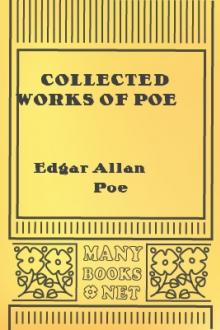Collected Works of Poe by Edgar Allan Poe (e reader TXT) 📕

- Author: Edgar Allan Poe
- Performer: -
Book online «Collected Works of Poe by Edgar Allan Poe (e reader TXT) 📕». Author Edgar Allan Poe
The Automaton Chess-Player was invented in 1769, by Baron Kempelen, a nobleman of Presburg, in Hungary, who afterwards disposed of it, together with the secret of its operations, to its present possessor. {2*} Soon after its completion it was exhibited in Presburg, Paris, Vienna, and other continental cities. In 1783 and 1784, it was taken to London by Mr. Maelzel. Of late years it has visited the principal towns in the United States. Wherever seen, the most intense curiosity was excited by its appearance, and numerous have been the attempts, by men of all classes, to fathom the mystery of its evolutions. The cut on this page gives a tolerable representation of the figure as seen by the citizens of Richmond a few weeks ago. The right arm, however, should lie more at length upon the box, a chess-board should appear upon it, and the cushion should not be seen while the pipe is held. Some immaterial alterations have been made in the costume of the player since it came into the possession of Maelzel--the plume, for example, was not originally worn. {image of automaton}
At the hour appointed for exhibition, a curtain is withdrawn, or folding doors are thrown open, and the machine rolled to within about twelve feet of the nearest of the spectators, between whom and it (the machine) a rope is stretched. A figure is seen habited as a Turk, and seated, with its legs crossed, at a large box apparently of maple wood, which serves it as a table. The exhibiter will, if requested, roll the machine to any portion of the room, suffer it to remain altogether on any designated spot, or even shift its location repeatedly during the progress of a game. The bottom of the box is elevated considerably above the floor by means of the castors or brazen rollers on which it moves, a clear view of the surface immediately beneath the Automaton being thus afforded to the spectators. The chair on which the figure sits is affixed permanently to the box. On the top of this latter is a chess-board, also permanently affixed. The right arm of the Chess-Player is extended at full length before him, at right angles with his body, and lying, in an apparently careless position, by the side of the board. The back of the hand is upwards. The board itself is eighteen inches square. The left arm of the figure is bent at the elbow, and in the left hand is a pipe. A green drapery conceals the back of the Turk, and falls partially over the front of both shoulders. To judge from the external appearance of the box, it is divided into five compartments--three cupboards of equal dimensions, and two drawers occupying that portion of the chest lying beneath the cupboards. The foregoing observations apply to the appearance of the Automaton upon its first introduction into the presence of the spectators.
Maelzel now informs the company that he will disclose to their view the mechanism of the machine. Taking from his pocket a bunch of keys he unlocks with one of them, door marked ~ in the cut above, and throws the cupboard fully open to the inspection of all present. Its whole interior is apparently filled with wheels, pinions, levers, and other machinery, crowded very closely together, so that the eye can penetrate but a little distance into the mass. Leaving this door open to its full extent, he goes now round to the back of the box, and raising the drapery of the figure, opens another door situated precisely in the rear of the one first opened. Holding a lighted candle at this door, and shifting the position of the whole machine repeatedly at the same time, a bright light is thrown entirely through the cupboard, which is now clearly seen to be full, completely full, of machinery. The spectators being satisfied of this fact, Maelzel closes the back door, locks it, takes the key from the lock, lets fall the drapery of the figure, and comes round to the front. The door marked I, it will be remembered, is still open. The exhibiter now proceeds to open the drawer which lies beneath the cupboards at the bottom of the box--for although there are apparently two drawers, there is really only one--the two handles and two key holes being intended merely for ornament. Having opened this drawer to its full extent, a small cushion, and a set of chessmen, fixed in a frame work made to support them perpendicularly, are discovered. Leaving this drawer, as well as cupboard No. 1 open, Maelzel now unlocks door No. 2, and door No. 3, which are discovered to be folding doors, opening into one and the same compartment. To the right of this compartment, however, (that is to say the spectators' right) a small division, six inches wide, and filled with machinery, is partitioned off. The main compartment itself (in speaking of that portion of the box visible upon opening doors 2 and 3, we shall always call it the main compartment) is lined with dark cloth and contains no machinery whatever beyond two pieces of steel, quadrant-shaped, and situated one in each of the rear top corners of the compartment. A small protuberance about eight inches square, and also covered with dark cloth, lies on the floor of the compartment near the rear corner on the spectators' left hand. Leaving doors No. 2 and No. 3 open as well as the drawer, and door No. I, the exhibiter now goes round to the back of the main compartment, and, unlocking another door there, displays clearly all the interior of the main compartment, by introducing a candle behind it and within it. The whole box being thus apparently disclosed to the scrutiny of the company, Maelzel, still leaving the doors and drawer open, rolls the Automaton entirely round, and exposes the back of the Turk by lifting up the drapery. A door about ten inches square is thrown open in the loins of the figure, and a smaller one also in the left thigh. The interior of the figure, as seen through these apertures, appears to be crowded with machinery. In general, every spectator is now thoroughly satisfied of having beheld and completely scrutinized, at one and the same time, every individual portion of the Automaton, and the idea of any person being concealed in the interior, during so complete an exhibition of that interior, if ever entertained, is immediately dismissed as preposterous in the extreme.
M. Maelzel, having rolled the machine back into its original position, now informs the company that the Automaton will play a game of chess with any one disposed to encounter him. This challenge being accepted, a small table is prepared for the antagonist, and placed close by the rope, but on the spectators' side of it, and so situated as not to prevent the company from obtaining a full view of the Automaton. From a drawer in this table is taken a set of chess-men, and Maelzel arranges them generally, but not always, with his own hands, on the chess board, which consists merely of the usual number of squares painted upon the table. The antagonist having taken his seat, the exhibiter approaches the drawer of the box, and takes therefrom the cushion, which, after removing the pipe from the hand of the Automaton, he places under its left arm as a support. Then taking also from the drawer the Automaton's set of chess-men, he arranges them upon the chessboard before the figure. He now proceeds to close the doors and to lock them--leaving the bunch of keys in door No. 1. He also closes the drawer, and, finally, winds up the machine, by applying a key to an aperture in the left end (the spectators' left) of the box. The game now commences--the Automaton taking the first move. The duration of the contest is usually limited to half an hour, but if it be not finished at the expiration of this period, and the antagonist still contend that he can beat the Automaton, M. Maelzel has seldom any objection to continue it. Not to weary the company, is the ostensible, and no doubt the real object of the limitation. It Wits of course be understood that when a move is made at his own table, by the antagonist, the corresponding move is made at the box of the Automaton, by Maelzel himself, who then acts as the representative of the antagonist. On the other hand, when the Turk moves, the corresponding move is made at the table of the antagonist, also by M. Maelzel, who then acts as the representative of the Automaton. In this manner it is necessary that the exhibiter should often pass from one table to the other. He also frequently goes in rear of the figure to remove the chess-men which it has taken, and which it deposits, when taken, on the box to the left (to its own left) of the board. When the Automaton hesitates in relation to its move, the exhibiter is occasionally seen to place himself very near its right side, and to lay his hand, now and then, in a careless manner upon the box. He has also a peculiar shuffle with his feet, calculated to induce suspicion of collusion with the machine in minds which are more cunning than sagacious. These peculiarities are, no doubt, mere mannerisms of M. Maelzel, or, if he is aware of them at all, he puts them in practice with a view of exciting in the spectators a false idea of the pure mechanism in the Automaton.
The Turk plays with his left hand. All the movements of the arm are at right angles. In this manner, the hand (which is gloved and bent in a natural way,) being brought directly above the piece to be moved, descends finally upon it, the fingers receiving it, in most cases, without difficulty. Occasionally, however, when the piece is not precisely in its proper situation, the Automaton fails in his attempt at seizing it. When this occurs, no second effort is made, but the arm continues its movement in the direction originally intended, precisely as if the piece were in the fingers. Having thus designated the spot whither the move should have been made, the arm returns to its cushion, and Maelzel performs the evolution which the Automaton pointed out. At every movement of the figure machinery is heard in motion. During the progress of the game, the figure now and then rolls its eyes, as if surveying the board, moves its head, and





Comments (0)